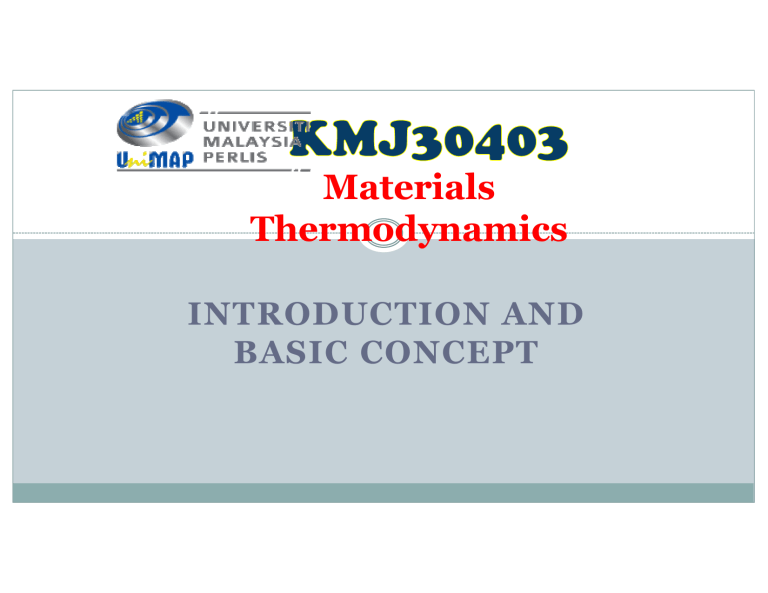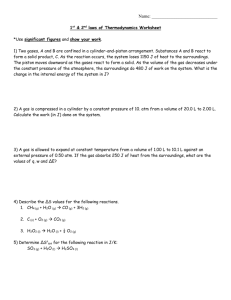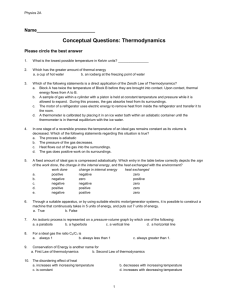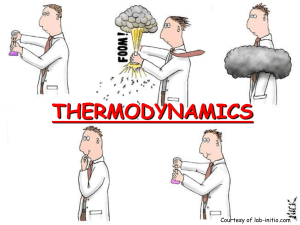
Materials Thermodynamics INTRODUCTION AND BASIC CONCEPT Why study Thermodynamics? Pervasive Applies to every volume element in every instant in time Established J. Willard Gibbs (1883) Equilibrium of Heterogeneous Substances – completed the apparatus of phenomenological thermodynamics Comprehensive Basic info how matter behaves Enables maps generation of equilibrium states Apparatus capable of handling most complex kinds of: system, applications & influences Identifies properties of systems important in wide range applications. Provide relationships between these database properties, predict matter behaviour Widely used in science & industry to answer real-world questions about the behaviour of matter DEFINITION OF THERMODYNAMICS Thermodynamics: The science of energy. 3 Energy: The ability to cause changes. The name thermodynamics stems from the Greek words therme (heat) and dynamis (force/power). Thermodynamics: The physical sciences that deal with energy and the transfer, transport, and conversion of energy. Thermodynamics application: Microscopic organisms Household appliances Transport vehicles Power generation Laws of Thermodynamics The ZEROTH LAW definition of temperature. of thermodynamics, which underlies the The FIRST LAW of thermodynamics, which mandates conservation of energy, and states in particular that heat is a form of energy. The SECOND LAW of thermodynamics, is about the quality of energy. It states that as energy is transferred/transformed, more and more of it is wasted. There is a natural tendency of any isolated system to degenerate into a more disordered state (entropy). The THIRD LAW of thermodynamics, which concerns on entropy of an object at absolute zero temperature, and implies that it is impossible to cool a system all the way to exactly absolute zero. The first law of thermodynamics: An expression of the conservation of energy principle. The first law asserts that energy is a thermodynamic property. Conservation of energy principle: 5 During an interaction, energy can change from one form to another but the total amount of energy remains constant. Energy cannot be created or destroyed. Conservation of energy principle for the human body. (diet industry) Energy cannot be created or destroyed; it can only change forms (the first law). The second law of thermodynamics: It asserts that energy has quality as well as quantity, and actual processes occur in the direction of decreasing quality of energy. A cup of hot coffee left on a table eventually cools, But a cup of cool coffee in the same room never gets hot by itself. Heat flows in the direction of decreasing temperature. A boiling pan of water is unlikely to ever become a block of ice. A smashed plate could never reassemble itself, as this would reduce the entropy of the system in defiance of the second law of thermodynamics. 6 Closed System Mass Flow dm dt 0 Open System Mass Flow System and Surroundings • System – quantity of matter or region in space chosen for study Surroundings Closed System • Surroundings – mass or region outside the system System Boundary Surroundings Control Surface Open System Mass flow ( Fixed space or volume) Open systems have mass flow across their boundaries. Surroundings Heat System • Closed system (control mass) – no mass can enter or leave a system • Also in special case system can be considered as isolated system Work Surroundings Mass Flow • Open system (control volume) – usually encloses a device that involves mass flow such as compressor, turbine or nozzle. Heat System Power Mass Flow • Closed system (Piston and Cylinder) m Piston • Open system (Gas Turbine Engine) Fuel Flow In Combustor Gas at pressure, p Shaft Work Output Air Flow In Compressor Work Out Exhaust Gases Out • Any characteristic of a system called property. • Some familiar properties are pressure, P, temperature, T, volume, V, and mass, m. • Properties are considered to be either intensive or extensive. • Intensive properties – those that are independent of the size of the system, such as temperature, pressure and density. • Extensive properties – those whose values depend on the size or extent of the system such as mass, volume and total energy. • Specific properties is the extensive properties per unit mass. m ½m ½m V ½V ½V T T T P P P Extensive properties Intensive properties Exothermic process is any process that gives off heat – transfers thermal energy from the system to the surroundings. 2H2 (g) + O2 (g) H2O (g) 2H2O (l) + energy H2O (l) + energy Endothermic process is any process in which heat has to be supplied to the system from the surroundings. energy + 2HgO (s) energy + H2O (s) 2Hg (l) + O2 (g) H2O (l) 6.2 Exothermic Endothermic 6.2 State functions are properties that are determined by the state of the system, regardless of how that condition was achieved. Energy, Pressure, Volume, Temperature E = Efinal - Einitial P = Pfinal - Pinitial V = Vfinal - Vinitial T = Tfinal - Tinitial Potential energy of hiker 1 and hiker 2 is the same even though they took different paths. 6.3 Non State functions are properties that are determined by how that condition was achieved. Work, Heat W ≠ Wfinal - Winitial q ≠ qfinal - qinitial Work done by hiker 1 and hiker 2 is different because they took two different paths. 6.3 First Law of thermodynamics – energy can be converted from one form to another, but cannot be created or destroyed. Esystem + Esurroundings = 0 or Esystem = -Esurroundings C3H8 + 5O2 3CO2 + 4H2O Exothermic chemical reaction! Chemical energy lost by combustion = Energy gained by the surroundings [system] [surroundings] 6.3 E = q + w E change in internal energy of a system q heat exchange between the system and the surroundings w work done on (or by) the system w = -PV when a gas expands against a constant external pressure Sign Conventions for Work and Heat Process Sign Work done by the system on the surroundings - Work done on the system by the surroundings + Heat absorbed by the system from the surroundings (endothermic) + Heat absorbed by the surroundings from the system (exothermic) - 6.3 Closed system does not allow mass transferred but, allow heat transferred between the system and surrounding. Because of that, all energy exchange between a closed system and its surrounding appears as heat and work. Therefore the second term of Equation can be stated as: Work E surrounding Q W Q and W always refer to the system, and the choice of the signs depends on the way energy or work transferred. If Q and W transfer into the system from the surroundings, then, the sign is +ve w = Fd w = -PV V > 0 -PV < 0 F P ꞏ V = 2 ꞏ d3 = Fd = w d wsys < 0 Work is not a state function! w = wfinal - winitial initial final 6.3 A sample of Nitrogen gas expands in volume from 1.6 L to 5.4 L at constant temperature. What is the work done in Joules if the gas expands (a) against a vacuum and (b) against a constant pressure of 3.7 atm? w = -PV (a) V = 5.4 L – 1.6 L = 3.8 L P = 0 atm W = -0 atm x 3.8 L = 0 L•atm = 0 Joules (b) V = 5.4 L – 1.6 L = 3.8 L P = 3.7 atm w = -3.7 atm x 3.8 L = -14.1 L•atm w = -14.1 L•atm x 101.3 J = -1430 J 1L•atm 6.3 Thermodynamics - General Terms Algebra relation between various state variables to form a thermodynamics system. 1 (at constant n and T) Boyle’s law: V P Charles’ law: V T (at constant n and P) Ideal Gas Equation: PV = nRT 2.4 Ideal Gas Model The relationship among the state 23 variables, temperature, pressure, and specific volume is called the equation of state. We now consider the equation of state for the vapour or gaseous phase of simple compressible substances. The Ideal-Gas Equation of State Recall that the combination of Boyle’s and Charles’ laws T P R v where R is the constant of proportionality and is called the gas constant and takes on a different value for each gas. The ideal gas equation of state may be written several ways. V mv mR ( MN ) R NR V v N Pv RT V P RT m PV mRT PV NR T V P RT N P = absolute pressure (MPa or kPa) molar specific volume in m /kmol Pv R T vT == absolute temperature (in K) 3 R= 24 8.314 kJ/kmol K Some values of the Universal Gas Constant, Ru 8.314 kJ/(kmol K) 25 8.314 kPa m3/(kmol K) 1.986 Btu/(lbmol R) 1545 ft lbf/(lbmol R) 10.73 psia ft3/(lbmol R) The ideal gas equation of state is used when; 1) The pressure is small compared to the critical pressure (P<Pcr) or 2) When the temperature is twice the critical temperature and the pressure is less than ten times the critical pressure (T= 2Tcr, P<10Pcr) The critical point is that state where there is an instantaneous change from the liquid phase to the vapor phase for a substance. Critical point data is given in Table A-1. 26 E = q + w At constant pressure, P: q = H and w = -PV E = H - PV H = E + PV 6.4 Enthalpy (H) is used to quantify the heat flow into or out of a system in a process that occurs at constant pressure. H = H (products) – H (reactants) H = heat given off or absorbed during a reaction at constant pressure Hproducts < Hreactants H < 0 Hproducts > Hreactants H > 0 6.4 Is H negative or positive? System absorbs heat H > 0 6.01 kJ are absorbed for every 1 mole of ice that melts at 0°C and 1 atm. H2O (s) H2O (l) H = 6.01 kJ 6.4 Is H negative or positive? System gives off heat H < 0 890.4 kJ are released for every 1 mole of methane that is combusted at 25°C and 1 atm. CH4 (g) + 2O2 (g) CO2 (g) + 2H2O (l) H = -890.4 kJ 6.4 • The stoichiometric coefficients always refer to the number of moles of a substance H2O (s) • H = 6.01 kJ If you reverse a reaction, the sign of H changes H2O (l) • H2O (l) H2O (s) H = -6.01 kJ If you multiply both sides of the equation by a factor n, then H must change by the same factor n. 2H2O (s) 2H2O (l) H = 2 x 6.01 = 12.0 kJ 6.4 • The physical states of all reactants and products must be specified in thermochemical equations. H2O (s) H2O (l) H = 6.01 kJ H2O (l) H2O (g) H = 44.0 kJ How much heat is evolved when 266 g of white phosphorus (P4) burns in air? P4 (s) + 5O2 (g) 266 g P4 x P4O10 (s) 1 mol P4 123.9 g P4 x H = -3013 kJ -3013 kJ = -6470 kJ 1 mol P4 6.4 The specific heat (s) of a substance is the amount of heat (q) required to raise the temperature of 1 gram of the substance by 1 degree Celsius. The heat capacity (C) of a substance is the amount of heat (q) required to raise the temperature of a given quantity (m) of the substance by 1 degree Celsius. The Specific Heats of Some Common Substances Substances Specific Heat (J/gꞏ°C) Al 0.900 Au 0.129 C (graphite) 0.720 C (diamond) 0.502 Cu 0.385 Fe 0.444 Hg 0.139 H2O 4.184 C2H5OH (ethanol) 2.46 C = ms Heat (q) absorbed or released: q = ms q = C = Tfinal - Tinitial 6.5 Specific heats Definition: The energy required to raise the temperature of a unit mass of a substance by 1 degree. Specific heat constant volume, Cv the energy required to raise the unit mass of a substance by 1 degree as the volume is maintained constant. Specific heat of constant pressure, Cp pressure is maintained constant. Cp Cv express the specific heats in terms of thermodynamic properties. Conservation of energy principle ein - eout = esystem C C v p u T h T change in u with T at constant V v change in h with T at constant P p common units: kJ/kgC or kJ/kgK molar basis, Cv & Cp: kJ/kmol C or kJ/kmolK 34 Internal energy, enthalpy & specific heats of ideal gas The differential changes in the internal energy & enthalpy of an ideal gas can be expressed as 35 du C v ( T ) dT dh C p ( T ) dT The integration in these equation can be performed, yielding u 2 u1 Cv ,av (T2 T1 ) (kJ/kg) h2 h1 C p ,av (T2 T1 ) u Cv ,av .T h C p ,av .T U mCv ,av .T H mC p ,av .T (kJ/kg) 36 There are three ways to determine u and h for ideal gases: 1. Using tabulated u and h data – when it is readily available 2. Using Cv and Cp as a function of temperature – perform integration –computerized 3. Using average Cv and Cp – convenient when property tables not available. Accurate if T is small Refer Table A-2 Specific heat relations of ideal gases 37 Derive relationship between specific heats. We know that h u pv h u RT Differentiate w.r.t T Which means that dh du R dT dT C p (T ) Cv (T ) R If CP and Cv remain constant with temperature; C p Cv R Specific heat ratio, k (kJ/kgK) k Cp Cv Internal energy, enthalpy & specific heats of solids & liquids Incompressible substance a substance whose specific volume(density) is constant Assumption: constant-volume should be taken to imply that the energy associated with the volume change is negligible compared with other forms of energy. 38 It can be mathematically shown that: C p Cv C Specific heat values for common solids & liquids are given in Table A-3 u Cav (T2 T1 ) h u vdP C av T v P How much heat is given off when an 869 g iron bar cools from 940C to 50C? Given: Specific heat (s) of Fe = 0.444 J/g • 0C t = tfinal – tinitial = 50C – 940C = -890C q = mst = 869 g x 0.444 J/g • 0C x –890C = -34,000 J 6.5 40 41 42 43 44 45


